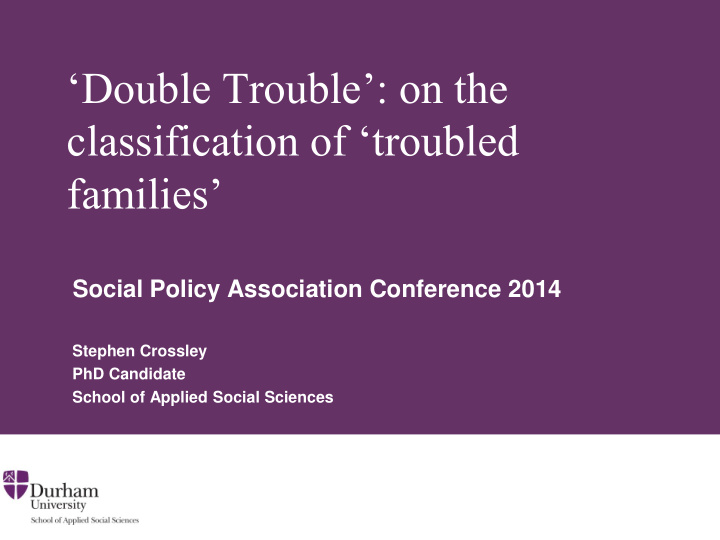



‘Double Trouble’: on the classification of ‘troubled families’ Social Policy Association Conference 2014 Stephen Crossley PhD Candidate School of Applied Social Sciences
The long history…. • 1880s Victorian residuum • 1910s The unemployables • 1930s Social Problem Group ∂ • 1940s The ‘problem family’ • 1960s Culture of poverty • 1970s Cycle of deprivation • 1980s Underclass • 1990s Socially excluded Welshman (2013)
The short history…. 120,000 families with ‘multiple disadvantages’… ∂ … became 120,000 ‘troubled families’
An ‘official’ social problem… Each society, at each moment, elaborates a body of social problems taken to be legitimate, worthy of being debated, of being made public and ∂ sometimes officialised and, in a sense, guaranteed by the state Bourdieu (1992: 236, original emphases)
Troubled Families Programme ∂ I hate the idea that we should just expect to pay ever larger amounts in welfare to an ever larger chunk of society and never expect the recipients to change their lives. Cameron (2011)
Framed by ‘austerity’ ∂ Our heart tells us we can’t just stand by while people live these lives and cause others so much misery. Our head tells us we can’t afford to keep footing the monumental bills for social failure . Cameron (2011)
A ‘dual problematization ’ The problem , particularly in the past ten years, has actually been an excess of unthinking, impersonal welfare. Put simply: tens of thousands ∂ of troubled families have been subjected to a sort of compassionate cruelty , swamped with bureaucracy, smothered in welfare yet never able to escape. Cameron (2011)
A ‘dual problematization ’ … troubled families are already pulled and prodded and poked a dozen times a week by government . Indeed one of the reasons for their ∂ dysfunction is their hatred of ‘the system’ which they experience as faceless, disjointed and intrusive. Cameron (2011)
‘Culprit’ and ‘accomplice’ … contemporary social policies attempt not only to reform individuals or social conditions – policy’s manifest targets – but also to reform the ∂ organizations responsible for putting policy into practice Brodkin (2011: 254)
A single solution… ‘What we know works is this thing called family intervention and what it does is basically get into the actual family, in their front room and if ∂ actually the kids aren’t in school it gets in there and says to the parents I’m gonna show you and explain to you exactly how to get your kids up and out every single day and then I’m gonna make you do it. And if you don’t do it, there are gonna be consequences’ Casey (2013a)
‘Looking at the family ‘from the inside out’’ 1. A dedicated worker, dedicated to a family 2. Practical ‘hands on’ support ∂ 3. A persistent, assertive and challenging approach 4. Considering the family as a whole 5. Common purpose & agreed action DCLG (2012: 15)
Positioning of FIPs FIPs are rationalised as a response to the inability of agencies to support these families . ∂ FIPs are constructed as a new brokering service enlisted to ‘grip’ both families and agencies involved with them Parr & Nixon (2008: 165)
Intergenerational failure… The stories of these families tell the history of a ∂ generation of initiatives, a generation of programmes, a generation of goals . Yet from generation to generation we have failed to stop the transmission of problems and disadvantage . In my view we have let them down Casey (2013b)
Family Service Units (1950s) The form of intervention they developed became known as intensive family casework and emphasised the importance of building close ∂ links with the family … and establishing a pattern of close supervision … Treatment … emphasised the successful performance of such tasks as getting the children out of bed on time to get to school and taking them there … Starkey (2000: 549)
Failing to learn the lessons By the mid-1950s, when the effects of post-war welfare provisions were beginning to be felt , and when public house-building programmes ∂ were starting to make inroads into the domain of the private landlord. Family Service Unit workers reported with some surprise that the ‘problem family’ was numerically less significant than it had been a decade earlier. Starkey (2000: 551-552)
Planning ahead… The next part of the challenge will be to ∂ understand more about how the success with families is achieved, and then to seek to widen this approach to a far larger group of families across the country; to reshape, redesign and refocus services . Casey (2012)
‘Changing the mainstream’? • A ‘massive expansion’ to include 400,000 ‘high - risk families’ • Expanded in last budget to work with 40,000 ∂ more ‘troubled families’ this financial year’. • Minimal ‘opposition’ to the TFP • IPPR propose a ‘Troubled Lives Programme’ to include ‘troubled’ individuals without children.
The ‘underclass’ thesis… … tends to be supported by those who wish to constrain the redistributive potential of state welfare and it has thus always been part of a ∂ broader conservative view of the aetiology of social problems and their correct solutions . Macnicol (1987: 316)
Contact details s.j.crossley@durham.ac.uk ∂ @akindoftrouble www.akindoftrouble.wordpress.com
Recommend
More recommend